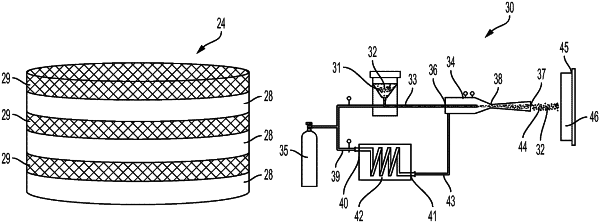| CPC B22F 10/25 (2021.01) [B22F 12/58 (2021.01); B33Y 10/00 (2014.12); B33Y 40/10 (2020.01); B33Y 80/00 (2014.12); H01R 4/58 (2013.01); H01R 43/16 (2013.01); B22F 2304/10 (2013.01)] | 17 Claims |

|
1. A method of forming an electrical contact comprising a functionally graded monolithic structure, the method comprising:
operating at least one material feeder to release a feed of a first metal selected from a group consisting of copper, silver, aluminum, gold, platinum, and combinations thereof, and a second metal selected from a group consisting of aluminum oxide, chromium, chromium carbide, tungsten, tungsten carbide, molybdenum, molybdenum carbide, vanadium, vanadium carbide, and combinations thereof,
wherein the first and second metals are each in a solid state and a powder form, and the second metal has a higher melting temperature as compared to a melting temperature of the first metal, and
wherein the melting temperatures of the first and second metals differ by at least 1400° F.;
depositing the first metal and second metal on a substrate by applying a compressed gas to the first and second metals to eject the first and second metals toward the substrate,
wherein the depositing is performed under a pressure sufficient to form a solid state bond between the first and second metals, and
wherein the first and second metals are ejected onto the substrate at an angle between 75° to 105°; and
forming an electrical contact comprising a functionally graded monolithic structure,
wherein an amount of the second metal as compared to an amount of the first metal increases with distance in the structure from a first surface of the structure to a second opposing surface of the structure such that the second metal content increases continuously or incrementally throughout height of the electrical contact, while maintaining the structure at a temperature that is below the melting temperature of both the first and second metals, keeping the first and second metals in a solid state.
|